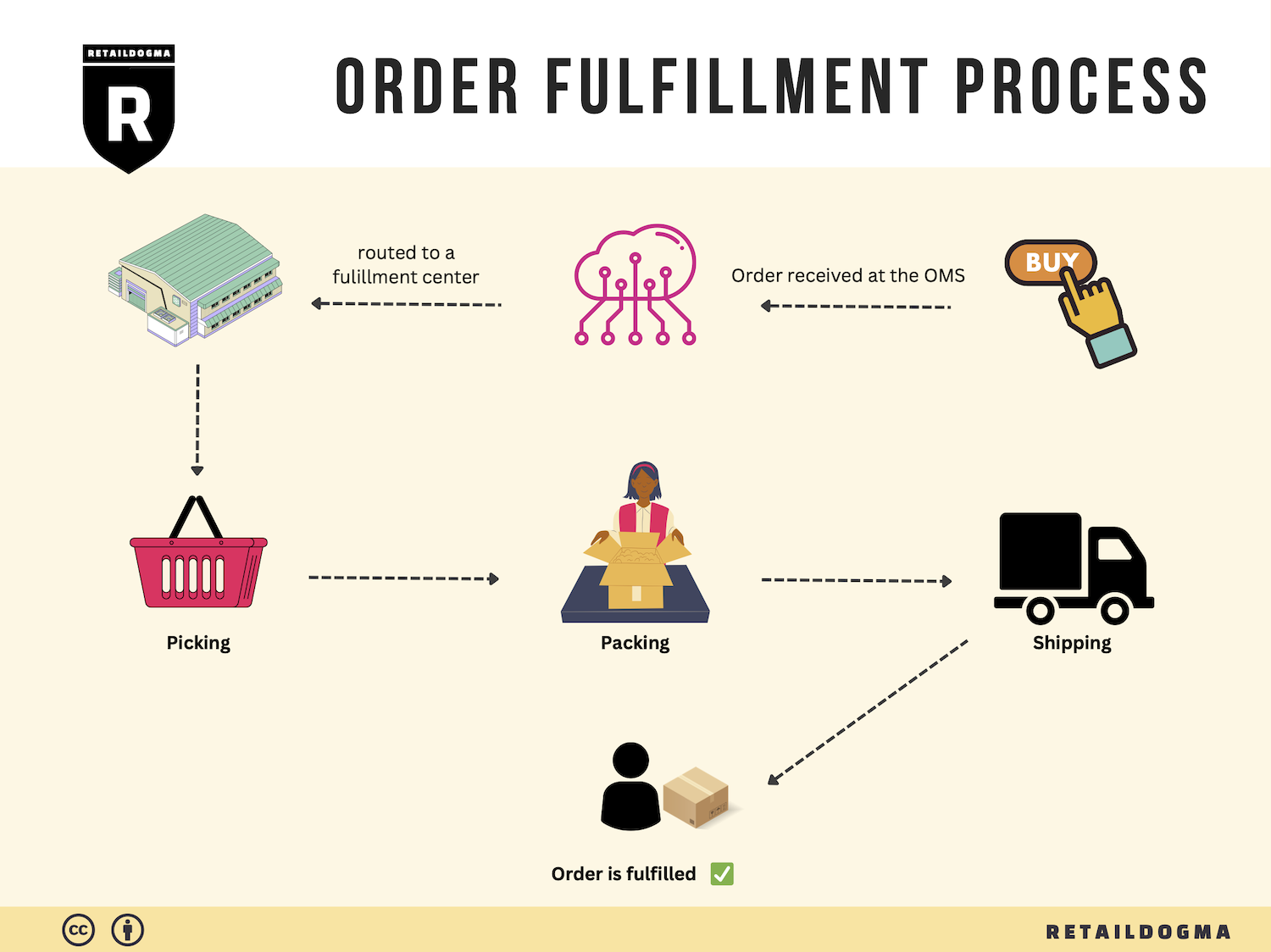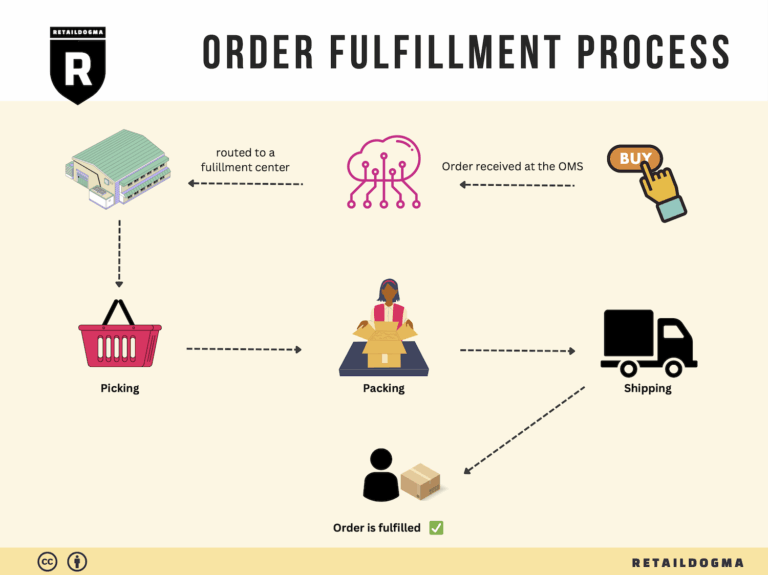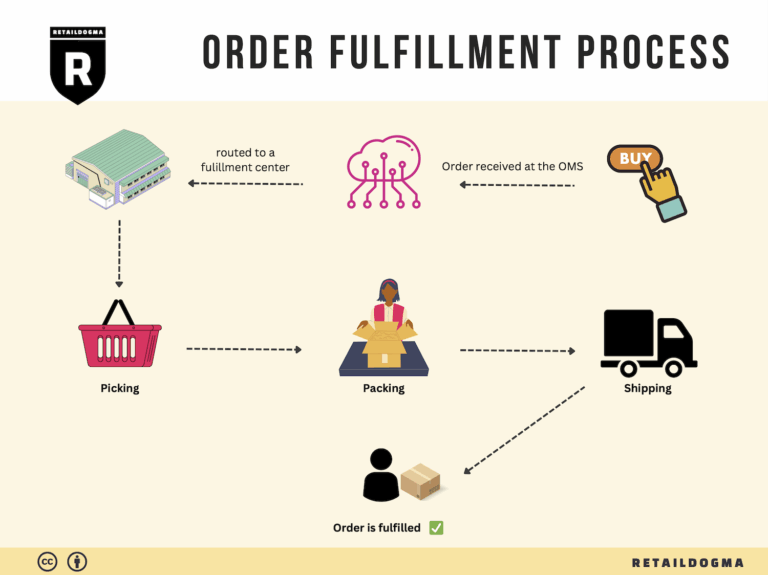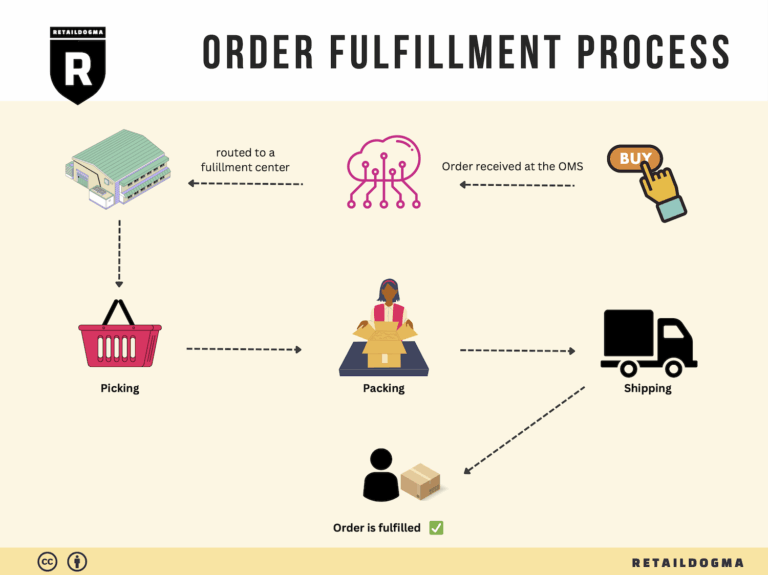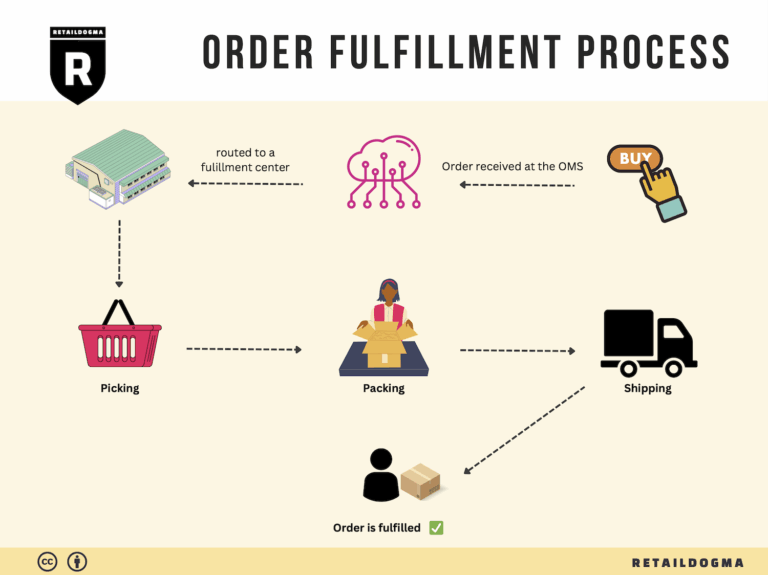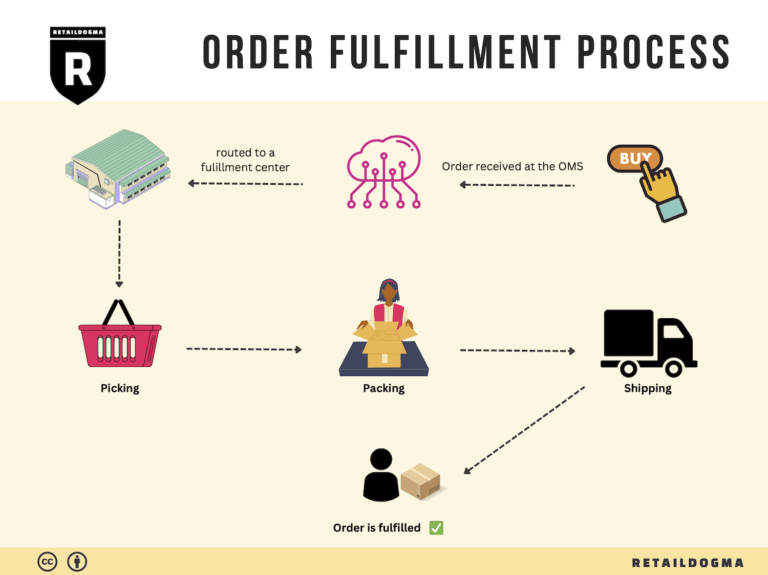How Order Fulfillment Works: A Step-by-Step Guide for Businesses
What is E-commerce Fulfillment? An Introduction for Growing Businesses
Understanding the Challenges of E-commerce Fulfillment
As a growing online business owner, you may find yourself overwhelmed by the complexities of packing and shipping orders. The excitement of attracting new customers can quickly turn into stress when faced with the logistical challenges of e-commerce fulfillment. From managing inventory to ensuring timely delivery, the fulfillment process can be time-consuming and fraught with potential pitfalls. This guide aims to demystify e-commerce fulfillment, helping you navigate this crucial aspect of your operations with confidence.
Defining E-commerce Fulfillment
At its core, e-commerce fulfillment is the process of getting a product from your warehouse to the customer’s doorstep. This includes a series of steps: receiving inventory, storing it, processing orders, picking and packing products, and finally shipping them. As your business scales, the need for an efficient fulfillment strategy becomes paramount. The right approach not only enhances customer satisfaction through timely deliveries but also optimizes your operations, allowing you to focus on growth.
What This Guide Will Cover
In this comprehensive guide, we will explore various fulfillment models, such as Third-Party Logistics (3PL) and Fulfillment by Amazon (FBA), to help you understand which might be the best fit for your business. We will delve into the core services that fulfillment partners provide, including inventory management, order processing, and returns handling.
Additionally, we’ll cover essential criteria for choosing a fulfillment partner, emphasizing the importance of compatibility with your business model, quality control measures, and technology integration. Understanding pricing structures and potential hidden costs is also crucial, as these factors can significantly impact your bottom line.
Empowering Your Business Decisions
Our goal is to empower your business to make informed decisions about your logistics strategy. By understanding the nuances of e-commerce fulfillment, you can select the right partners and solutions that align with your operational needs and customer expectations. With the right fulfillment strategy in place, you can streamline your processes, reduce overhead costs, and ultimately drive growth in your e-commerce business. Let’s embark on this journey to mastering fulfillment together.
What You’ll Learn In This Guide
- What is E-commerce Fulfillment? An Introduction for Growing Businesses
- The Order Fulfillment Process: From ‘Buy’ Button to Customer’s Door
- Comparing Fulfillment Models: In-House vs. 3PL vs. Dropshipping
- A Deep Dive into Amazon FBA: Pros, Cons, and Who It’s For
- Core Services Offered by Fulfillment Centers
- How to Choose a Fulfillment Partner: A 6-Point Checklist
- Understanding Fulfillment Pricing: A Breakdown of Common Fees
- Frequently Asked Questions (FAQs) about Fulfillment
- Conclusion: Is Outsourcing Fulfillment the Right Move for Your Business?
- Important Disclaimer
The Order Fulfillment Process: From ‘Buy’ Button to Customer’s Door
1. Receiving Inventory
The first step in the order fulfillment process is receiving inventory. This involves accepting shipments of products from suppliers and manufacturers. When inventory arrives at the fulfillment center, it must be carefully inspected for accuracy and quality. This includes checking against purchase orders to ensure that the right quantities and items have been received, as well as assessing the condition of the products.
Importance: Efficient receiving processes are crucial for maintaining accurate inventory levels and minimizing discrepancies. If inventory is not correctly accounted for, it can lead to stockouts, overstocking, and ultimately dissatisfied customers.
Key Term: SKU (Stock Keeping Unit) – Each product variant is assigned a unique SKU to track inventory effectively, facilitating better management and reporting.
2. Warehouse Storage
Once the inventory has been received and verified, it must be stored appropriately within the warehouse. This involves organizing products in a way that optimizes space and accessibility. Effective warehouse storage systems utilize various shelving methods and categorization techniques, such as grouping similar items or using a bin system for easy retrieval.
Importance: Proper storage is vital for efficient order fulfillment. It minimizes the time needed to locate products during the picking process and helps maintain the integrity of the items stored. An organized warehouse can significantly reduce labor costs and improve overall efficiency.
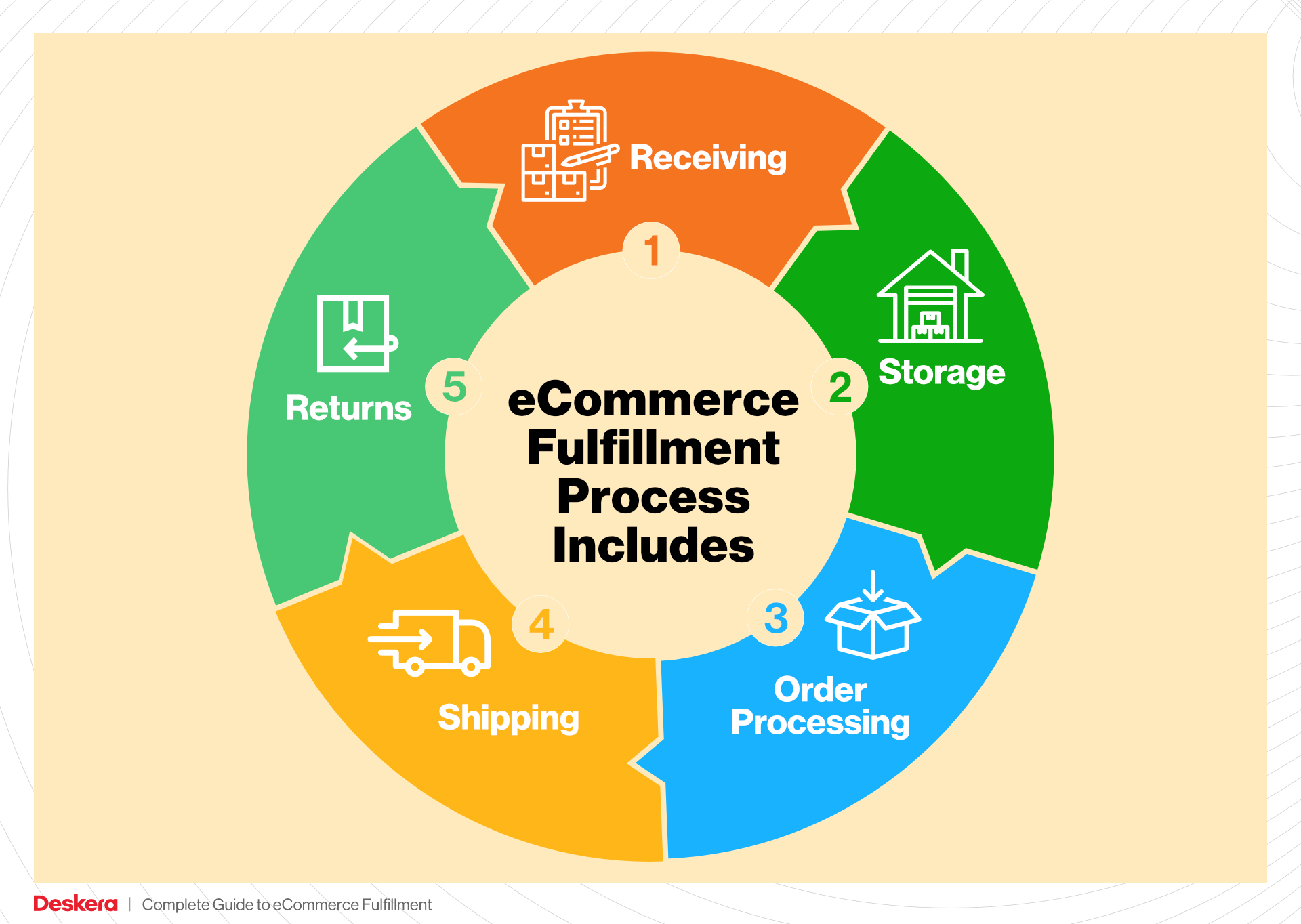
Key Term: FIFO (First In, First Out) – This inventory management method ensures that older stock is sold before newer arrivals, reducing the risk of obsolescence, particularly important for apparel that may go out of style.
3. Order Picking
Order picking is the process of retrieving items from the warehouse to fulfill customer orders. This step typically begins when a customer places an order through the e-commerce platform. Warehouse staff use pick lists, which detail the items required for each order, to gather products from their respective storage locations.
Importance: The speed and accuracy of order picking directly impact customer satisfaction. Errors in picking can lead to incorrect shipments and increased return rates, which can be costly for apparel brands. Efficient picking processes help ensure that customers receive the correct items quickly, fostering loyalty and repeat business.
Key Term: Pick Lists – These documents or digital tools guide warehouse staff on which items to retrieve for each order, streamlining the picking process and reducing mistakes.
4. Order Packing
After items are picked, the next step is order packing. This involves securely packaging products for shipment, ensuring they arrive at the customer’s door in pristine condition. Proper packing methods include selecting the right-sized boxes, using protective materials like bubble wrap or tissue paper, and including packing slips and return instructions.
Importance: Effective packing not only protects items during transit but also enhances the overall customer experience. Thoughtfully packaged orders can leave a lasting impression, contributing to brand loyalty. Additionally, well-packed orders can reduce the likelihood of returns due to damage.
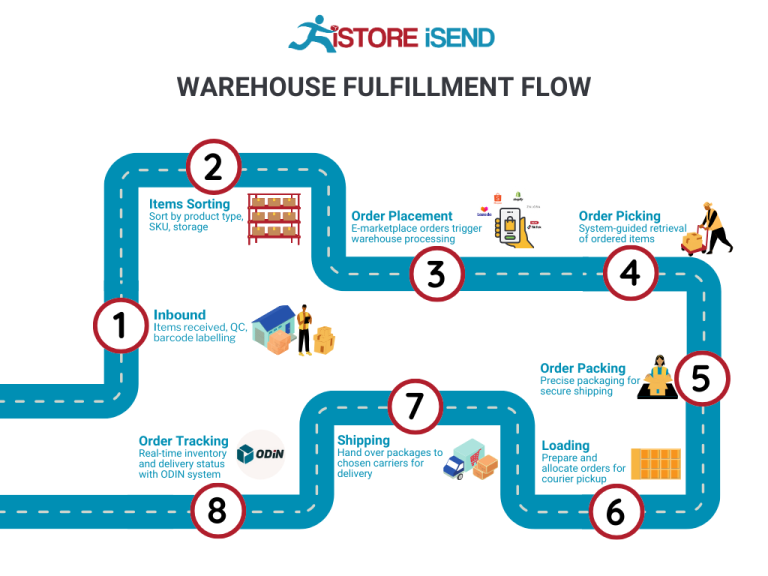
Key Term: Packaging Materials – The various materials used to pack items, such as boxes, cushioning, and tape, which play a crucial role in protecting products during shipping.
5. Shipping & Delivery
The final step in the order fulfillment process is shipping and delivery. Once orders are packed, they are handed off to shipping carriers for delivery to the customer. This stage involves selecting the appropriate shipping method based on factors such as cost, delivery speed, and destination.
Importance: Fast and reliable shipping is a key factor in customer satisfaction. In today’s e-commerce landscape, customers expect timely delivery, often within a few days. Efficient shipping processes can enhance a brand’s reputation and encourage repeat purchases.
Key Term: Last-Mile Delivery – This term refers to the final step of the delivery process, where the package is transported from a distribution center to the customer’s doorstep. Optimizing last-mile delivery can significantly impact customer satisfaction and operational efficiency.
In conclusion, understanding and optimizing each step of the order fulfillment process is essential for e-commerce businesses, particularly in the apparel sector. By focusing on receiving, storage, picking, packing, and shipping, brands can enhance their operational efficiency, improve customer satisfaction, and ultimately drive sales growth.
Comparing Fulfillment Models: In-House vs. 3PL vs. Dropshipping
Fulfillment Model Comparison
| Model | Who Handles Inventory | Best For (Business Stage) | Key Advantage | Key Disadvantage |
|---|---|---|---|---|
| In-House Fulfillment | Your business | Startups and established brands | Full control over operations | High operational costs |
| Third-Party Logistics (3PL) | 3PL provider | Scaling businesses | Cost-effectiveness and scalability | Less control over inventory |
| Dropshipping | Supplier | Startups with low capital | Low upfront investment | Lower profit margins |
In-House Fulfillment
In-house fulfillment involves managing the entire fulfillment process within your own facilities. This model is often favored by startups and established brands that have the resources to invest in warehousing, inventory management systems, and staffing. The primary advantage of in-house fulfillment is the level of control it offers. Businesses can oversee every aspect of the operation—from inventory management to shipping processes—ensuring that products are handled according to their specific quality and branding standards. This model also allows for more personalized customer service, as teams can quickly adapt to customer feedback or operational challenges.
However, in-house fulfillment comes with significant drawbacks, particularly in terms of operational costs. Businesses must invest in warehouse space, technology, and labor, which can strain finances, especially for smaller brands. Additionally, managing inventory in-house can lead to challenges such as overstocking or stockouts, particularly if demand fluctuates unexpectedly. As a brand scales, the complexities of logistics can quickly become overwhelming, making it essential to have robust systems in place to manage operations effectively.
Third-Party Logistics (3PL)
Third-party logistics (3PL) providers specialize in managing logistics and fulfillment for e-commerce businesses. This model is ideal for brands looking to scale operations without the burden of managing inventory and logistics in-house. 3PLs handle everything from storage and order processing to shipping and returns, allowing businesses to focus on growth and customer engagement. The key advantage of partnering with a 3PL is cost-effectiveness; these providers can often negotiate better shipping rates due to their volume and have established systems that streamline the fulfillment process.
Moreover, 3PLs offer scalability, enabling businesses to adjust their logistics operations in response to seasonal demand or growth without the need for significant capital investment. However, the trade-off is a loss of control over the fulfillment process. Businesses may find it challenging to maintain their brand standards or ensure quality control, particularly if the 3PL lacks specific expertise in handling apparel. Additionally, reliance on a third party can lead to communication challenges, especially if the provider is not proactive in sharing inventory updates or addressing issues.
Dropshipping
Dropshipping is a fulfillment model where the retailer does not keep products in stock but instead transfers customer orders to a supplier, who then ships the products directly to the customer. This model is particularly advantageous for startups or entrepreneurs with limited capital, as it eliminates the need for upfront inventory purchases and warehousing costs. With dropshipping, businesses can offer a wide range of products without the financial risk associated with holding inventory.
However, while dropshipping has a low barrier to entry, it also comes with significant drawbacks. Profit margins are typically lower, as suppliers often charge higher prices for their services. Additionally, businesses have limited control over product quality, shipping times, and inventory levels, which can lead to customer dissatisfaction. Since multiple retailers may use the same suppliers, competition can be fierce, making it challenging to differentiate a brand. Moreover, if a supplier runs out of stock or delays shipping, it can directly impact the retailer’s reputation and customer satisfaction. Thus, while dropshipping offers flexibility and low startup costs, it requires careful management and strategic planning to ensure a successful operation.
Conclusion
Each fulfillment model presents unique advantages and challenges, and the best choice depends on the specific needs and circumstances of your business. In-house fulfillment offers control and personalization but can be costly and complex. Third-party logistics provide scalability and cost savings but may reduce direct oversight. Dropshipping is attractive for low-capital startups but can lead to lower margins and quality concerns. As you consider your options, assess your operational capacity, customer expectations, and long-term growth goals to determine the fulfillment strategy that best aligns with your business vision.
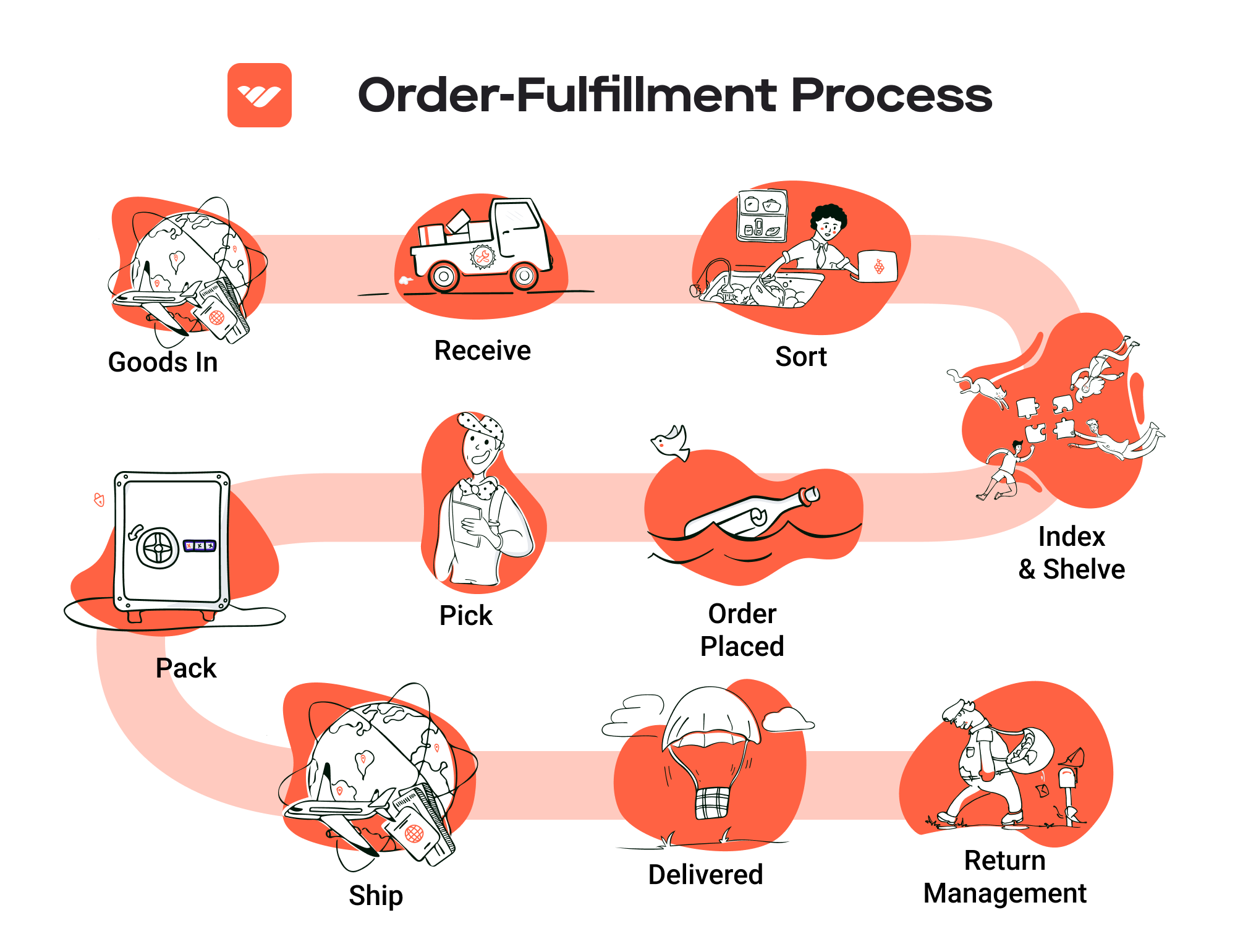
A Deep Dive into Amazon FBA: Pros, Cons, and Who It’s For
Understanding Fulfillment by Amazon (FBA)
Fulfillment by Amazon (FBA) is a service provided by Amazon that allows e-commerce sellers to leverage Amazon’s vast logistics network to store, pack, and ship their products. By using FBA, sellers can focus on growing their business while Amazon handles the logistics of order fulfillment, customer service, and returns.
How FBA Works
-
Setting Up FBA: Sellers begin by creating an Amazon Seller account and enrolling in the FBA program. They then list their products on Amazon, indicating which items will be fulfilled through FBA.
-
Shipping Inventory to Amazon: Once products are listed, sellers must send their inventory to Amazon’s fulfillment centers. Amazon provides guidance on how to package and ship items, including labeling requirements.
-
Storage and Management: After the inventory arrives at the fulfillment center, Amazon stores the products until an order is placed. Sellers can monitor their inventory levels through the Amazon Seller Central dashboard.
-
Order Fulfillment: When a customer orders a product, Amazon picks, packs, and ships the item on behalf of the seller. This process is highly automated and designed to ensure fast delivery.
-
Customer Service and Returns: Amazon handles all customer service inquiries related to FBA orders, including returns. This allows sellers to focus on other aspects of their business without the burden of managing logistics.
Pros of Fulfillment by Amazon (FBA)
-
Prime Eligibility: One of the most significant advantages of using FBA is that products become eligible for Amazon Prime. This can substantially increase visibility and sales, as Prime members are more likely to purchase items that offer fast, free shipping.
-
Customer Trust: Amazon is a trusted platform, and using FBA can enhance a seller’s credibility. Customers often feel more secure purchasing products that are fulfilled by Amazon, knowing they have access to Amazon’s customer service and return policies.
-
Multi-Channel Fulfillment: FBA is not limited to orders placed on Amazon. Sellers can also use FBA to fulfill orders from their own websites or other sales channels, making it a versatile solution for managing inventory and logistics.
-
Scalability: FBA allows businesses to scale quickly without needing to invest in their own warehousing and logistics. As demand increases, sellers can send more inventory to Amazon’s fulfillment centers without worrying about the complexities of storage and order processing.
-
Reduced Operational Burden: By outsourcing fulfillment to Amazon, sellers can free up time and resources, allowing them to focus on marketing, product development, and customer engagement.
Cons of Fulfillment by Amazon (FBA)
-
High Fees: FBA comes with a variety of fees, including storage fees for inventory stored in Amazon’s warehouses and fulfillment fees based on the size and weight of the products. These costs can add up quickly, especially for sellers with lower margins.
-
Strict Inventory Rules: Amazon has strict guidelines regarding inventory management, including requirements for labeling, packaging, and storage. Sellers must adhere to these rules to avoid penalties or issues with their listings.
-
Commingling Risks: When products are commingled, sellers’ items are mixed with inventory from other sellers. This can lead to complications, such as receiving returns for items that were not originally sold by a seller. This risk can be a significant concern for brands that prioritize quality control.
-
Less Control Over Fulfillment: While outsourcing fulfillment can be beneficial, it also means that sellers have less control over the fulfillment process. Issues like delays, incorrect shipments, or damaged items may occur, and sellers must rely on Amazon to resolve these problems.
-
Inventory Limits: Amazon imposes limits on the amount of inventory sellers can store at their fulfillment centers, especially for new sellers. This can hinder growth if sellers are unable to keep sufficient stock on hand to meet demand.
Who is FBA Best For?
Fulfillment by Amazon is an excellent choice for several types of sellers:
-
Small to Medium-Sized Businesses: For those who lack the resources to manage their own fulfillment operations, FBA offers a way to access a vast logistics network without the overhead costs of warehousing and staffing.
-
Brands Seeking Visibility: Sellers who want to capitalize on Amazon’s massive customer base and leverage Prime membership benefits will find FBA particularly advantageous.
-
Retailers with High Sales Volume: Businesses that anticipate high sales volume and rapid order fulfillment will benefit from Amazon’s efficient logistics, allowing them to scale quickly without compromising service quality.
-
Multi-Channel Sellers: Brands that sell on multiple platforms can use FBA to streamline their fulfillment process across different sales channels, enhancing efficiency and customer satisfaction.
-
Seasonal Businesses: Sellers with seasonal products can benefit from FBA’s scalability, as they can send inventory to Amazon only during peak seasons without the need for long-term storage solutions.
In conclusion, while Fulfillment by Amazon offers numerous advantages that can help e-commerce businesses grow and thrive, it is essential for sellers to consider the associated costs and operational constraints. Understanding these factors will enable sellers to make informed decisions about whether FBA aligns with their business goals and operational capabilities.
Core Services Offered by Fulfillment Centers
Inventory Management & Warehousing
Inventory management and warehousing are foundational services offered by fulfillment centers that ensure an e-commerce business maintains optimal stock levels. This involves storing products in a secure, organized environment where they can be easily accessed and tracked. Advanced inventory management systems allow businesses to monitor stock in real-time, manage SKUs, and forecast demand based on sales trends.
Benefits: Effective inventory management minimizes the risk of stockouts and overstocking, which can lead to lost sales and increased carrying costs. By utilizing sophisticated software, fulfillment centers can provide businesses with insights into inventory turnover rates, helping them make informed purchasing decisions. Additionally, a centralized warehousing solution streamlines logistics, reducing transportation costs and ensuring that products are stored close to key markets for faster delivery. This capability is particularly important for clothing brands with diverse offerings that need to be readily available to meet customer demands.
Pick and Pack Services
Pick and pack services are critical in the order fulfillment process, involving the selection of products from inventory (picking) and packaging them for shipment (packing). Fulfillment centers employ systematic processes and technology to ensure that orders are fulfilled accurately and efficiently. Automation tools, such as barcode scanners and inventory management software, help streamline these operations, reducing the likelihood of human error.
Benefits: The primary advantage of pick and pack services is speed. In an e-commerce landscape where consumers expect fast delivery, fulfillment centers can process orders quickly, often within the same day. This not only enhances customer satisfaction but also encourages repeat purchases. Furthermore, accurate picking and packing reduce the costs associated with returns due to shipping errors, ensuring that customers receive exactly what they ordered. By outsourcing this function, businesses can focus on other critical areas, such as marketing and product development, while leaving the logistics to experts.
Kitting and Assembly
Kitting and assembly services involve combining multiple products into a single package or preparing items for sale. This could include assembling clothing sets, bundling accessories, or creating gift packages. Fulfillment centers can manage these processes, ensuring that items are packaged according to specific requirements or promotional strategies.
Benefits: Kitting and assembly provide a significant advantage for e-commerce businesses looking to enhance their product offerings. By offering bundled products or unique packaging, brands can create additional value for customers, potentially increasing average order value and boosting sales. Additionally, this service allows businesses to streamline their operations by outsourcing complex assembly tasks to fulfillment centers, which have the expertise and resources to execute them efficiently. This not only saves time but also reduces the operational burden on in-house teams.
Returns Management (Reverse Logistics)
Returns management, often referred to as reverse logistics, is an essential service provided by fulfillment centers that allows businesses to handle product returns efficiently. This process includes accepting returned items, inspecting them for quality, restocking them if applicable, and managing any necessary repairs or refurbishments. A well-structured returns management system can significantly impact customer satisfaction and loyalty.
Benefits: The ability to manage returns effectively is crucial for e-commerce businesses, particularly in the apparel industry, where return rates can be significantly higher than in other sectors. A streamlined returns process can enhance the customer experience by providing clear instructions for returns, quick processing of refunds, and timely communication. This not only helps maintain customer trust but also encourages repeat purchases. Additionally, an efficient returns management system can provide valuable insights into customer preferences and product quality issues, informing future business decisions and inventory management strategies. By outsourcing this function to a fulfillment center, businesses can reduce operational costs and focus on core activities while still delivering exceptional service to their customers.
In conclusion, partnering with a fulfillment center that offers these core services—inventory management & warehousing, pick and pack, kitting and assembly, and returns management—can provide e-commerce businesses with the efficiency, scalability, and customer satisfaction needed to thrive in a competitive market. By leveraging the expertise of fulfillment centers, businesses can streamline their operations, reduce costs, and ultimately enhance their brand’s reputation.
How to Choose a Fulfillment Partner: A 6-Point Checklist
Location & Warehouse Network
Importance:
The geographical location of your fulfillment partner’s warehouses plays a crucial role in shipping speed and cost. A partner with strategically located warehouses can significantly reduce delivery times and shipping expenses, enhancing customer satisfaction.
Questions to Ask:
– How many fulfillment centers do you operate, and where are they located?
– Can you provide coverage maps to illustrate your shipping reach?
– How do you handle shipping to remote or rural areas?
– Are your warehouses equipped to manage peak season demands efficiently?
Technology & Integrations
Importance:
In today’s fast-paced e-commerce environment, leveraging technology is essential for streamlined operations. A fulfillment partner with robust technological capabilities can provide real-time inventory tracking, order processing automation, and integrations with your existing e-commerce platform.
Questions to Ask:
– What inventory management software do you use, and how does it integrate with popular e-commerce platforms (like Shopify, WooCommerce, etc.)?
– Do you offer real-time tracking and reporting? Can I access this data easily?
– How do you ensure data security and backup for our inventory and customer information?
– Are there additional costs associated with technology upgrades or integrations?
Specializations (e.g., Cold Storage, Oversized Items)
Importance:
Different types of products require specialized handling. For apparel brands, this might include managing delicate items, seasonal clothing, or items requiring cold storage. Ensuring your fulfillment partner has experience with your product type can prevent costly errors and enhance customer satisfaction.
Questions to Ask:
– Do you have experience handling apparel, and what specific processes do you have in place for quality control?
– Can you accommodate special needs, such as cold storage for seasonal items or oversized product handling?
– How do you manage returns for products with high return rates, such as apparel?
– What quality control measures do you implement to ensure product integrity during storage and shipping?
Scalability & Capacity
Importance:
As your business grows, your fulfillment needs will likely change. A suitable partner should have the capacity and flexibility to scale operations up or down based on your business’s seasonal demands and growth trajectory.
Questions to Ask:
– How do you handle fluctuations in order volume during peak seasons?
– What is your process for scaling operations to meet increased demand?
– Are there limitations to your capacity that we should be aware of?
– How do you ensure that you can meet our fulfillment needs as we grow?
Pricing and Contracts
Importance:
Understanding the cost structure and contract terms is vital to maintaining healthy profit margins. A transparent pricing model allows you to anticipate costs and avoid unexpected fees that could affect your bottom line.
Questions to Ask:
– Can you provide a detailed breakdown of your pricing model, including any hidden fees (e.g., storage, pick-and-pack, shipping)?
– What are the terms of your contracts? Are there any long-term commitments?
– Do you offer flexible pricing options, such as pay-as-you-go or tiered pricing based on volume?
– How often do you review pricing, and what factors could lead to price changes?
Customer Support & Reviews
Importance:
Reliable customer support is essential for resolving issues quickly and maintaining smooth operations. Additionally, reviews and testimonials from other clients provide insight into a partner’s reliability and service quality.
Questions to Ask:
– What kind of customer support do you provide? Is it available 24/7?
– How do you handle issues related to order fulfillment or shipping errors?
– Can you share case studies or references from similar businesses in our industry?
– What is your average response time for support inquiries, and how do you measure customer satisfaction?
By carefully evaluating potential fulfillment partners using this checklist, you can ensure that you select a provider who aligns with your business goals and can support your growth in the competitive apparel market. Each of these factors is critical in creating a seamless fulfillment process that keeps your customers happy and your operations efficient.
Understanding Fulfillment Pricing: A Breakdown of Common Fees
Initial Setup Fees
When partnering with a third-party logistics (3PL) provider for your apparel fulfillment, initial setup fees are often the first cost you’ll encounter. These fees typically cover the onboarding process, which includes integrating your e-commerce platform with the fulfillment center’s systems, setting up inventory management processes, and customizing the storage and handling of your products.
The calculation of initial setup fees can vary significantly based on the complexity of your business model and the specific requirements of your inventory. For instance, a brand with a large number of SKUs or specialized packaging needs may incur higher fees. On average, businesses can expect to pay anywhere from a few hundred to several thousand dollars for initial setup.
Receiving Fees
Receiving fees are charged when your inventory arrives at the fulfillment center. This fee covers the cost of unloading, inspecting, and logging your products into the system. It ensures that your items are accounted for and ready for storage or order fulfillment.
Receiving fees are typically calculated per shipment or per pallet, depending on the 3PL’s pricing structure. For example, a 3PL might charge a flat fee of $25 to $50 per pallet received. If your shipment contains multiple pallets, the total receiving fee would scale accordingly. Additionally, if your products require special handling or inspection, this could incur extra charges.
Storage Fees (per pallet/bin)
Storage fees are ongoing costs that you will incur as long as your inventory is stored at the fulfillment center. These fees compensate the 3PL for the space your products occupy, as well as for the management and security of your inventory.
Storage fees can be calculated in various ways, most commonly on a per-pallet or per-bin basis. For instance, a typical rate might range from $10 to $25 per pallet per month, while bin storage can be charged at a rate of $2 to $5 per bin per month. It’s essential to monitor your inventory turnover and adjust your storage needs accordingly to avoid unnecessary costs, especially during peak seasons.
Pick & Pack Fees (per item/order)
Pick and pack fees are incurred each time an order is processed. This fee covers the labor involved in picking the items from storage, packing them into boxes, and preparing them for shipment. Given the nature of the apparel industry, where order quantities and SKUs can vary greatly, these fees can fluctuate significantly.
The calculation for pick and pack fees is usually based on the number of items per order. For example, a 3PL may charge $1 to $3 per item picked and packed. If an order contains multiple items, the total fee would multiply accordingly. Some providers may offer tiered pricing, where the cost per item decreases as the order quantity increases, incentivizing larger orders.
Shipping Fees
Shipping fees are one of the most critical components of fulfillment pricing, as they directly affect your overall costs and customer satisfaction. These fees cover the transportation of your products from the fulfillment center to your customers’ doorsteps.
Shipping fees can vary widely based on several factors, including the shipping method (standard, expedited, etc.), the weight and dimensions of the package, and the destination. Many fulfillment centers negotiate discounted rates with carriers based on shipping volume, which can lead to significant savings for your business.
It’s important to note that some fulfillment providers may charge a handling fee in addition to standard shipping fees, which is intended to cover the packaging and preparation of your items for shipment. This could range from $0.50 to $2.00 per order, depending on the provider.
Tips for Getting an Accurate Quote
-
Be Transparent About Your Needs: When seeking quotes, provide potential partners with detailed information about your products, order volume, and specific fulfillment needs. This will help them give you a more accurate estimate.
-
Ask for Itemized Pricing: Request an itemized breakdown of all potential fees, including setup, receiving, storage, pick & pack, and shipping. This transparency will allow you to compare providers effectively.
-
Consider Seasonal Variability: If your business experiences seasonal fluctuations, discuss how pricing may change during peak periods and whether the provider offers consistent pricing throughout the year.
-
Evaluate Additional Services: Some 3PLs offer value-added services, such as returns management or custom packaging, which may affect pricing. Make sure to consider these when comparing quotes.
-
Negotiate Terms: Don’t hesitate to negotiate terms, especially if you anticipate high order volumes. Many fulfillment providers are willing to adjust pricing for long-term partnerships.
By understanding these common fulfillment pricing models and following these tips, you can make informed decisions that align with your business goals and help optimize your e-commerce operations.
Frequently Asked Questions (FAQs) about Fulfillment
1. What is apparel fulfillment?
Apparel fulfillment encompasses the processes involved in storing, packing, and shipping clothing products. It is typically handled by third-party logistics providers (3PLs) or dedicated apparel fulfillment centers that specialize in managing the unique requirements of the clothing industry, such as diverse SKUs and high return rates.
2. What is a 3PL?
A 3PL, or third-party logistics provider, is a company that offers logistics services to businesses, including warehousing, inventory management, order fulfillment, and shipping. For clothing brands, partnering with a 3PL can streamline operations, reduce costs, and enhance customer satisfaction by leveraging their expertise and resources.
3. What’s the difference between a warehouse and a fulfillment center?
While both warehouses and fulfillment centers store products, their functions differ significantly. A warehouse primarily focuses on inventory storage, often without direct involvement in order processing. In contrast, a fulfillment center specializes in processing customer orders, including picking, packing, and shipping items, as well as managing returns.
4. How much do fulfillment services cost?
The cost of fulfillment services can vary widely based on factors such as order volume, storage space, shipping methods, and specific services provided. Generally, businesses can expect to pay for storage (per pallet or square foot), picking and packing fees (per order), and shipping costs. It’s crucial to compare different providers to find a solution that fits your budget and operational needs.
5. How can I choose the right fulfillment partner for my clothing brand?
Selecting the right fulfillment partner involves evaluating their compatibility with your business model, industry experience, quality control measures, technology capabilities, and customer support. Look for a partner that understands the specific challenges of apparel fulfillment, such as managing high return rates and diverse SKUs, and one that offers flexibility to adapt to your scaling needs.
6. What are the benefits of outsourcing fulfillment?
Outsourcing fulfillment can lead to numerous benefits, including reduced operational costs, improved efficiency, access to advanced technology, and the ability to focus on core business functions like marketing and product development. Additionally, a reliable fulfillment partner can enhance customer satisfaction through faster shipping and better inventory management.
7. How does fulfillment impact customer satisfaction?
Efficient fulfillment plays a crucial role in customer satisfaction by ensuring timely and accurate order delivery. Fast shipping, low shipping costs, and streamlined returns processes contribute to a positive shopping experience, encouraging repeat purchases and fostering brand loyalty.
8. What should I look for in a fulfillment center’s technology?
When evaluating a fulfillment center’s technology, prioritize features like real-time inventory tracking, automated order processing, integration capabilities with your existing e-commerce platform, and data analytics tools. These technologies can significantly enhance operational efficiency and provide insights into customer behavior and inventory management.
9. How can I manage returns effectively in apparel fulfillment?
Effective returns management is vital for apparel brands due to the high return rates in the industry. Work with a fulfillment partner that has a robust returns process, allowing for easy return handling, inspection, and reintegration of items into your inventory. Clear return policies and streamlined communication with customers can also enhance their experience.
10. What are the key components of a successful apparel fulfillment strategy?
A successful apparel fulfillment strategy includes efficient inventory management, streamlined order processing, and effective distribution methods. It should leverage technology for automation, maintain high-quality standards, and be flexible enough to adapt to seasonal demand fluctuations. Additionally, fostering good relationships with your 3PL can enhance collaboration and operational success.
Conclusion: Is Outsourcing Fulfillment the Right Move for Your Business?
Evaluating the Benefits of Outsourcing Fulfillment
Outsourcing fulfillment can be a transformative strategy for e-commerce businesses, especially in the apparel sector. The key benefits are multifaceted, encompassing time savings, scalability, and specialized expertise. By partnering with a fulfillment provider, you can significantly reduce the time spent on logistics, allowing you to focus on core business activities like product development and marketing. With the right partner, you gain the ability to scale operations seamlessly, adapting to seasonal fluctuations and unexpected surges in demand without the hassle of managing additional staff or resources.
Moreover, fulfillment services bring a wealth of expertise that can enhance your operational efficiency. A specialized partner understands the unique challenges of apparel fulfillment, from managing high SKU counts to optimizing returns. They offer advanced inventory management systems, real-time tracking, and robust customer service capabilities, all of which contribute to a smoother, more reliable shopping experience for your customers.
However, the benefits of outsourcing fulfillment are only realized when you choose the right partner. Not all fulfillment providers are created equal; it’s crucial to evaluate their capabilities, industry experience, and alignment with your business model. Take the time to assess potential partners to ensure they can meet your specific needs and help drive your growth.
Call to Action
As you contemplate the future of your e-commerce business, consider conducting a thorough audit of your current shipping and fulfillment processes. Are you struggling with delays, high operational costs, or inventory management challenges? If so, it may be time to explore whether a fulfillment partner can provide the support and expertise you need to scale effectively. Start by outlining your specific requirements and researching potential partners that align with your business goals. Your next step could be the key to unlocking greater efficiency and customer satisfaction.
Important Disclaimer
⚠️ Important Disclaimer
The information in this guide is for educational purposes. Fulfillment services, pricing, and platform features change frequently. Always conduct your own due diligence and consult with providers directly before making business decisions.
